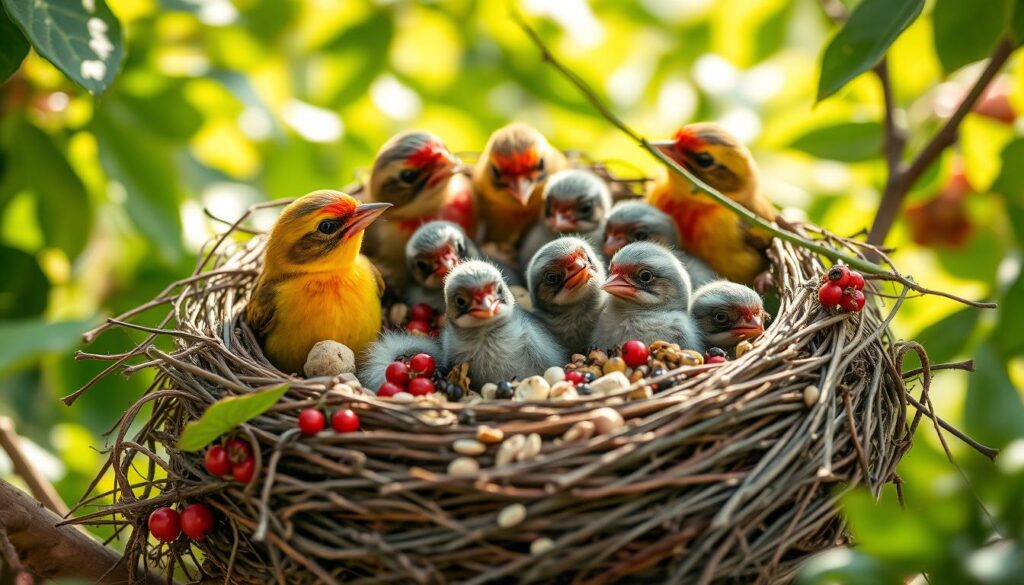Did you know American robins feed their babies up to 150 times a day? Each baby robin eats its weight in insects, worms, and berries daily. This shows how different young birds’ diets can be.
As baby birds grow, their food needs change a lot. Hummingbirds start with a mix of nectar and insects. Cedar waxwings move from eating insects to fruits after just two days. It’s really interesting to see how their diets change.
Key Takeaways
- Baby birds have diverse dietary needs depending on their species and stage of development.
- Most songbird nestlings primarily consume protein-rich insects, even if the adult birds are seed-eaters.
- Baby hummingbirds eat a slurry of regurgitated nectar and small insects, while cedar waxwings switch from insects to fruits after two days.
- American robins can deliver an astonishing 100-150 meals per day to their nest, with each baby eating its weight in insects, worms, and berries.
- Proper nutrition is crucial for the healthy growth and development of baby birds in the wild.
Understanding Baby Bird Development Stages
Baby birds grow in two main ways: altricial and precocial. Altricial birds, like songbirds and hummingbirds, hatch without feathers and need their parents for everything. Precocial birds, such as ducks and geese, are more developed at birth. They have down feathers and can find food soon after hatching.
The journey from hatchling to fledgling is key. During the nestling stage, baby birds grow feathers fast. This stage is crucial for nestling bird feeding and care.
Altricial vs Precocial Birds
- Altricial birds hatch naked and helpless, needing constant care and feeding from their parents.
- Precocial birds are more developed at birth, with down feathers and the ability to find their own food shortly after hatching.
From Hatchling to Fledgling
- Hatchling: Newly hatched baby birds, often bald and with eyes closed, completely dependent on their parents.
- Nestling: Baby birds that are still developing in the nest, undergoing rapid growth and feather development.
- Fledgling: Young birds that have left the nest but are still reliant on their parents for fledgling bird meals and care.
Critical Growth Periods
The nestling stage is crucial for baby birds. It’s when they grow fast and develop feathers. Meeting their chick dietary needs and care during this time is vital for their survival and growth into adulthood.
Natural Feeding Patterns in the Wild
In the wild, parent birds feed their young all day. Songbirds and passerines give their chicks insects for protein. This helps their chicks grow fast. As they get older, parents teach them to eat the right foods for their species.
Fledglings learn to find food by watching their parents. They try different things to find food. This helps them get ready to hunt and feed themselves when they’re older.
“Feeding the young is a full-time job for parent birds in the wild. They work tirelessly to ensure their chicks get the proper nutrition for healthy growth and development.”
The food baby birds eat changes a lot depending on the species. Birds like sparrows, robins, and bluebirds eat insects, worms, and larvae. These foods are full of protein and help the chicks grow fast.

Other birds, like pigeons and doves, give their chicks special food called “pigeon milk.” It’s full of fats and proteins. Birds that eat fruit, seeds, and insects feed their young with these foods. Birds that live in water, like herons and kingfishers, give their chicks fish, amphibians, or invertebrates. This makes sure their chicks get a balanced diet.
What Do Baby Birds Eat?
Baby birds eat different things based on their type, but mostly they have a diet rich in protein. They eat insects, worms, and larvae. Some also eat berries and fruits, which are important for their growth.
Protein-Rich Insects
Insects are the main food for most songbird babies. Doug Tallamy’s research shows that 96% of birds feed their young insects, not berries or seeds. Even small birds like chickadees need thousands of caterpillars to grow.
Worms and Larvae
Worms and larvae are also key in baby birds’ diets. They are full of protein, which helps young birds grow fast. Baby robins, for example, eat their own weight in insects, worms, and berries every day.
Berries and Fruits
Berries and fruits are also part of some baby birds’ diets. Cedar waxwings start with insects but then eat different fruits as they get older.
| Food Source | Percentage of Baby Bird Diet |
|---|---|
| Insects | 96% |
| Worms and Larvae | Variable, depending on species |
| Berries and Fruits | Variable, depending on species |
The availability of these baby bird food sources can be affected by many things. Removing mature native trees and declining insect populations are big factors. This shows how important it is to keep our ecosystems healthy to meet the needs of what do baby birds eat.
Songbird and Passerine Nutrition Guide
Caring for newborn bird food and hatchling bird nutrition is special for songbirds and passerines. A good diet can be made from common ingredients.
Mixing mynah bird pellets or dry dog food with hot water, baby food, cooked turkey, and egg yolk works well. This mix is like oatmeal and gives birds all they need without extra water.
As birds grow, adding natural foods is key. They need insects, worms, berries, and fruits. These are vital for a healthy hatchling bird nutrition plan.
“A diet for songbirds could comprise approximately 40% pre-soaked Purina One+PLUS small breed Lamb & Rice Formula Dog Food, 30% Purina wild game bird starter, 10% raw, skinned, deboned chicken quarters with fat removed, 10% whole hard-boiled eggs, and 10% Purina Friskies Shreds Chicken in Gravy canned cat food.”
Creating a newborn bird food plan with both artificial and natural foods is crucial. It helps songbirds and passerines get the nutrients they need during their growth.
Feeding Frequency and Portions
Caring for baby birds is all about finding the right balance. Altricial birds, like robins and cardinals, are born helpless. They need constant care for food and warmth.
These young birds must be fed every 15 to 20 minutes from dawn till dusk. This mimics their parent birds’ demanding feeding schedule.
Daytime Feeding Schedule
Feeding baby birds three times a day is recommended. Meals should be every 15 to 20 minutes during the day. This schedule helps them grow fast.
As they get older, their diet can include more insects, worms, and fruits.
Nighttime Feeding Habits
Baby birds don’t need food at night. They sleep through the dark hours. But, they should be fed before bed and in the morning.
It’s important to watch how much they eat. Too much or too little can harm them.
Feeding baby birds the right amount at the right time is key. Knowing what different birds need helps them grow strong and healthy. This way, they can become adult birds successfully.
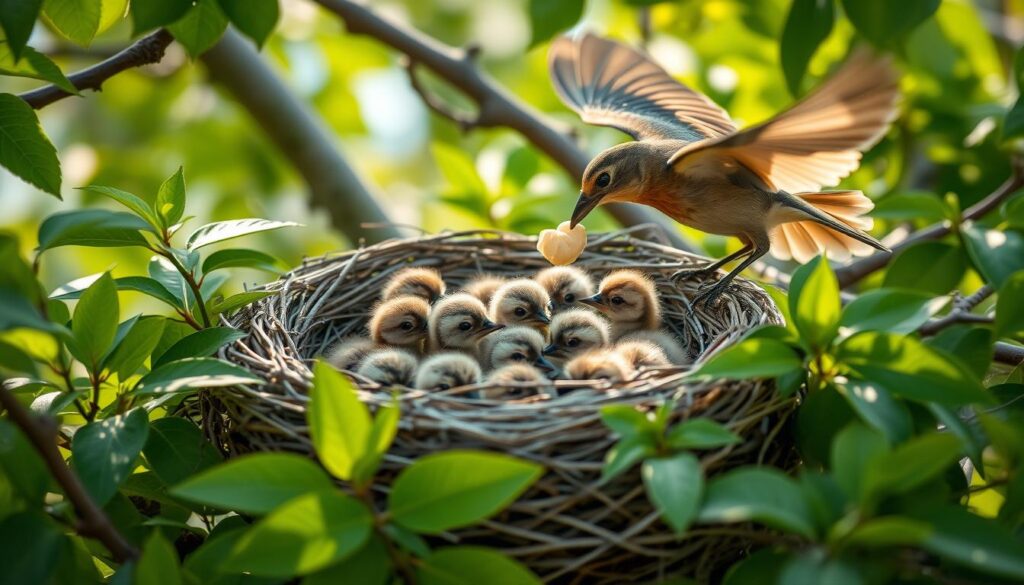
Essential Nutrients for Baby Bird Growth
Caring for baby birds means knowing their special diet needs. It’s key for their quick growth and health. They need lots of protein, vitamins, minerals, and other nutrients for their fast development.
Protein is very important for baby birds. It makes up most of their feathers, muscles, and tissues. Insects and worms are great for their protein needs. Fruits, seeds, and berries give them energy. Calcium is also key for their bones.
- Calcium is the most prevalent mineral in a young bird’s body.
- Feathers are over 90% protein, primarily keratins.
- Feathers contain 25% of the total protein found within a bird’s entire body.
Pigments like carotenoids and melanin are also important. They help with feather color, which affects a bird’s looks and breeding. Good nutrition is vital for baby birds’ healthy growth.
| Nutrient | Importance |
|---|---|
| Protein | Supports feather, muscle, and tissue development |
| Carbohydrates | Provides energy for growth and activity |
| Calcium | Crucial for bone and eggshell formation |
| Pigments (carotenoids, melanin) | Contribute to vibrant feather coloration |
Knowing what baby birds need helps caregivers give them the right food. This ensures they grow strong and healthy.
Safe Feeding Techniques and Methods
Caring for baby birds needs gentle and careful feeding. Use small plastic syringes or droppers to feed them. For very young birds, the food should be a bit warmer than room temperature, around 102-106 degrees Fahrenheit.
Feeding should be slow, letting the bird swallow between each mouthful. As they grow and get feathers, you can give them moistened dog food or crushed blueberries. Always use soft spoons or tweezers to feed them, keeping them safe.
Using Syringes and Droppers
Feeding baby birds with a small plastic syringe or dropper is best. It helps control how much they eat and lets you watch their intake. This is especially good for very young, featherless nestlings that need help eating.
Temperature Requirements
It’s important to keep the food at the right temperature for baby birds. The best temperature is between 102-106 degrees Fahrenheit. This keeps them comfortable and helps them digest food well, supporting their growth.
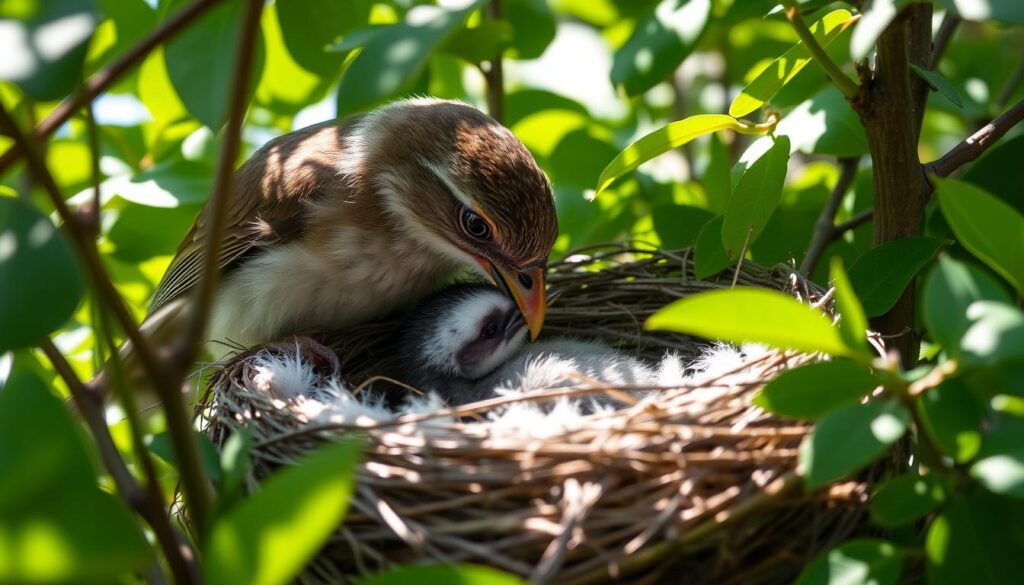
“The key to successful baby bird feeding is patience, precision, and attention to their unique needs. By adopting safe techniques and monitoring the temperature, you can provide the essential nourishment they require for healthy development.”
Common Feeding Mistakes to Avoid
Caring for baby birds needs careful and informed feeding. Even those who mean well can make mistakes that harm a young bird’s health. Here are some common baby bird diet and newborn bird food errors to avoid.
One big mistake is overfeeding. This can cause serious problems like aspiration. It’s not always right to give more food, as birds have specific needs. Giving milk is also bad, as birds can’t digest it.
Another error is force-feeding birds that don’t want to eat. This is very stressful and dangerous for the baby bird. Also, never give water directly, as it can drown them. Make sure the newborn bird food is the right consistency for hydration.
- Avoid overfeeding, which can lead to aspiration
- Do not provide inappropriate foods like milk that birds cannot digest
- Never force-feed birds that are not actively gaping
- Never give water directly, as it can cause drowning
It’s best to talk to a wildlife rehabilitator for feeding advice. They can guide you based on the baby bird’s species and age. With the right care, you can help these birds grow healthy.
| Common Feeding Mistake | Potential Consequences |
|---|---|
| Overfeeding | Aspiration, respiratory distress |
| Providing inappropriate foods (e.g., milk) | Digestive issues, malnutrition |
| Force-feeding birds not actively gaping | Stress, injury |
| Giving water directly | Drowning |
“Caring for baby birds requires attentive and informed feeding practices to ensure their health and development.”
Special Dietary Needs by Species
Understanding the avian diet for young birds is key. Each bird species has its own nutritional needs. These needs are important for their growth and health.
Hummingbird Babies
Hummingbird babies mainly eat nectar and tiny insects. They need lots of energy to grow fast. Caregivers must give them nectar and insect puree rich in protein.
Waterfowl Chicks
Waterfowl like ducks and geese have different chick dietary needs. They can eat chick starter or turkey starter feed. It’s important to match their diet to what they would eat in the wild.
Knowing about juvenile avian diet and chick dietary needs is vital. Tailoring the diet to each bird’s needs helps them thrive. This way, caregivers can help these young birds grow strong.
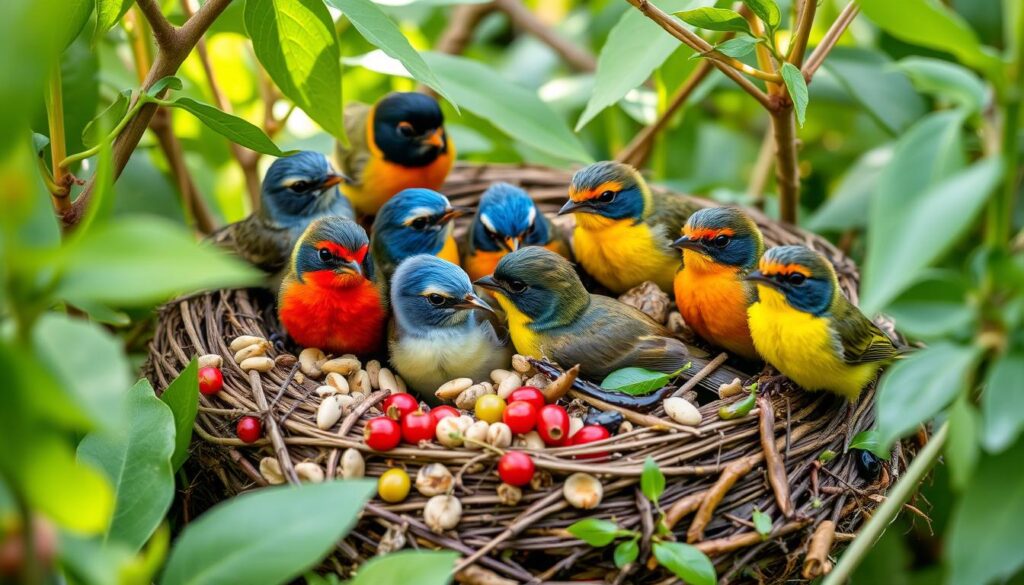
When to Help an Orphaned Baby Bird
As a bird lover, knowing when to help an orphaned or injured baby bird is crucial. It’s important to make sure the bird is safe without messing with its natural growth. First, watch the situation closely to see if the bird really needs help.
Many young birds, called fledglings, are still being watched by their parents, even if they seem alone on the ground. Parents might be around, taking care of their babies in different spots. Only step in if the bird is in real danger, like being in a busy street or near predators.
If you think the bird is hurt or orphaned, the best thing to do is call a licensed baby bird care wildlife expert. They know how to help fledgling bird assistance and make sure the bird can go back to the wild safely.
“It’s illegal in many states to raise a baby bird or any type of wildlife yourself. Incorrect care can lead to defects, growth abnormalities, and even death.”
Trying to care for a wild baby bird by yourself can be risky and is often against the law. Each bird needs special food and a certain environment to grow right. The wrong food or care can harm the bird a lot.
If you find a nestling or an injured fledgling, the best thing to do is keep it warm, quiet, and safe. Then, call a wildlife expert right away. They know how to give the special baby bird care these birds need.
Always put the baby bird’s well-being first. By knowing when to help and getting professional help, you can make sure the bird gets the best care possible.
Creating the Right Feeding Environment
Creating the right feeding environment is key for baby birds to grow well. The right temperature, humidity, and nesting setup are vital. They help in keeping hatchling birds healthy and alive during their early days.
Temperature Control
Newborn birds need a warm, cozy place to grow. Use a 40-watt heat lamp, 12 inches away, for warmth. The ideal temperature for them is 95-97°F (35-36°C).
As they grow and get feathers, lower the temperature to 75-85°F (24-29°C).
Nesting Setup
Make a nest with a small basket or container and soft materials like toilet paper. Put it in an aquarium or enclosed space. This mimics their natural habitat.
As they get bigger, move them to larger spaces with perches. Use modified laundry baskets. Keep the environment clean, warm, and safe from predators.
Proper baby bird care and hatchling bird environment are essential. They ensure the birds grow healthy and strong. The right temperature, humidity, and nesting setup are crucial for their success.
| Baby Bird Growth Stage | Optimal Temperature Range | Humidity Requirement |
|---|---|---|
| Hatchlings (no feathers) | 95-97°F (35-36°C) | Relative humidity greater than 50% |
| Pin Feathers Present | 75-85°F (24-29°C) | Relative humidity greater than 50% |
| Fully Feathered | 70-74°F (21-23°C) | Relative humidity greater than 50% |
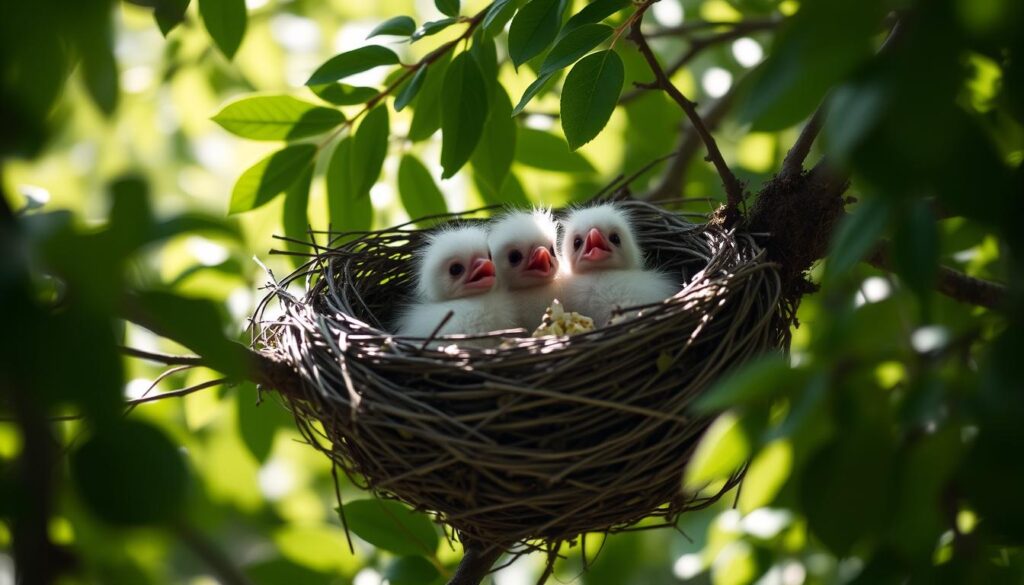
“Maintaining the correct temperature and humidity levels is crucial for the healthy development of baby birds, especially during the critical early stages.”
Transitioning to Adult Bird Diet
As fledgling birds grow, they need a diet for adults. This change from nestling food to adult food helps them become independent. It’s important for their growth and health.
Songbirds and passerines need more insects, seeds, berries, and fruits. Waterfowl should eat more aquatic plants and small invertebrates. Watching the bird and getting advice from a wildlife expert is key.
Encouraging Independent Feeding
Put adult foods in the bird’s enclosure or nest. This lets the young bird try new foods. It’s important to offer many different foods for a successful transition to an adult juvenile avian diet.
Monitoring Consumption and Growth
Watch how much the bird eats and its overall health. If it eats less, loses weight, or acts strangely, it might need different food. Keeping a regular feeding schedule and checking on the bird daily helps it adjust to adult food.
“The weaning process is a gradual, species-specific journey, and each bird may progress at its own pace. Patience and close observation are essential to supporting a healthy transition to independence.”
Managing the bird’s diet transition is crucial for their growth and health. With the right care, young birds can thrive as they grow up and explore the world.
Conclusion
Feeding and caring for baby birds needs knowledge, dedication, and sometimes expert help. It’s important to help birds that are truly orphaned or hurt. But, we should also let them grow naturally when we can.
Knowing what baby birds need to eat and grow is key. This helps us support and enjoy these fragile creatures in our wild bird worlds.
Feeding them the right foods, like insects, is crucial. We must also watch their growth closely and keep them clean. This ensures they stay healthy.
Creating the right home and food for them helps parent birds raise their young. This boosts the variety of life in our areas.
It’s all about finding the right balance when caring for baby birds. We can help, but we must also follow nature’s lead. Talking to wildlife experts is important for their best care.
Learning more about baby bird feeding and wild bird care helps us protect our feathered friends. This way, we can make a real difference in their lives.
FAQ
What do baby birds eat?
Baby birds eat different things based on their type and how old they are. Most songbird babies mainly eat insects because they are full of protein. Some birds also eat worms, larvae, and fruits.
How do baby birds develop?
Birds grow in two main ways: altricial and precocial. Altricial birds, like songbirds, are born without feathers and need their parents for food. Precocial birds, like ducks, can find food soon after they hatch.
They go through stages from hatchling to nestling to fledgling. This means they start as new birds, grow in the nest, and then leave the nest but still need their parents.
How do parent birds feed their young in the wild?
In the wild, parents feed their babies all day. Songbirds eat insects to help them grow fast. As they get older, parents give them foods that are right for their species.
What nutrients do baby birds need?
Baby birds need a lot of protein to grow quickly. They also need carbs and vitamins from fruits and seeds, and calcium for their bones.
How should baby birds be fed?
Use a small syringe or dropper to feed baby birds. For very young ones, make sure the food is a bit warmer than room temperature. Feed them slowly, letting them swallow between each mouthful.
For older birds with feathers, you can give them moistened dog food or crushed blueberries.
What are common mistakes when feeding baby birds?
Don’t overfeed, as it can cause problems. Also, don’t give them milk or water, as they can’t digest it. Never force-feed a bird that’s not opening its mouth. And never give water directly, as it can drown them.
How do the dietary needs vary by bird species?
Hummingbird babies need nectar and tiny insects. Waterfowl chicks can eat chick starter or turkey starter from feed stores. It’s very important to give the right food for each bird species.
When should I help an orphaned baby bird?
Make sure the bird really is orphaned before helping. Many fledglings on the ground are still being cared for by their parents. If a bird is in danger, move it to a safer place nearby. For injured birds, call a local wildlife rehabber.
How should I set up the feeding environment for baby birds?
For newborns without feathers, use a heat lamp with a 40-watt bulb at least 12 inches away. Make a nest with a small basket or container lined with toilet paper. As they grow, move them to bigger enclosures with perches. Make sure the place is clean, warm, and safe from predators.
